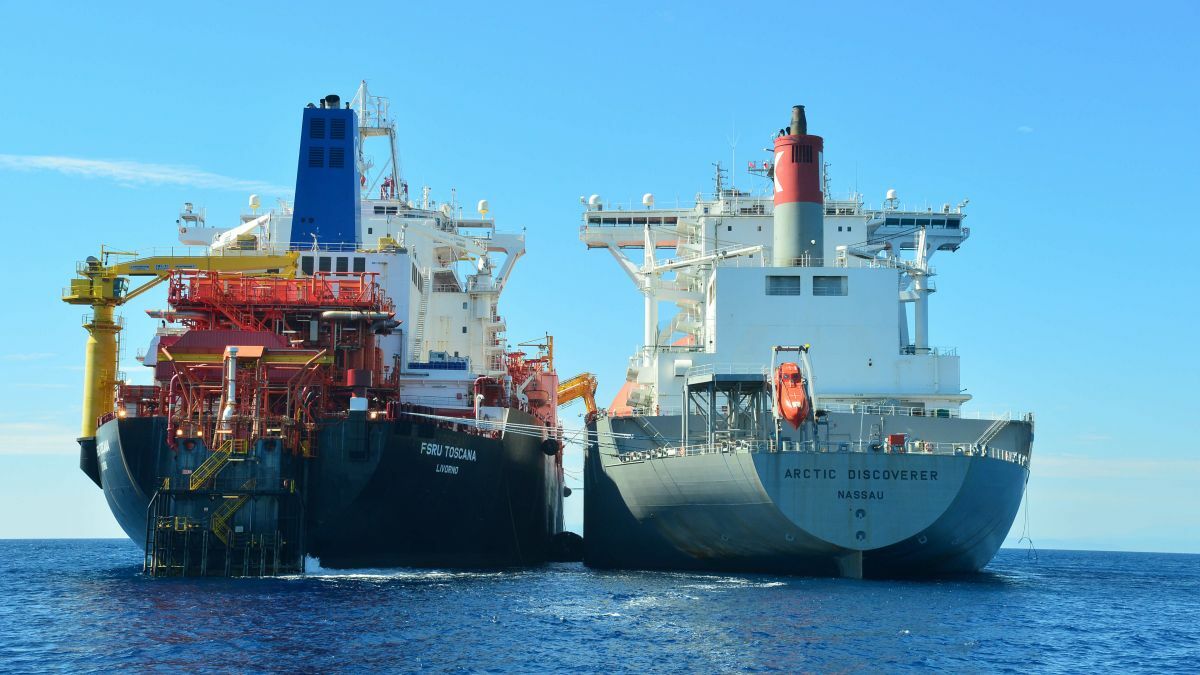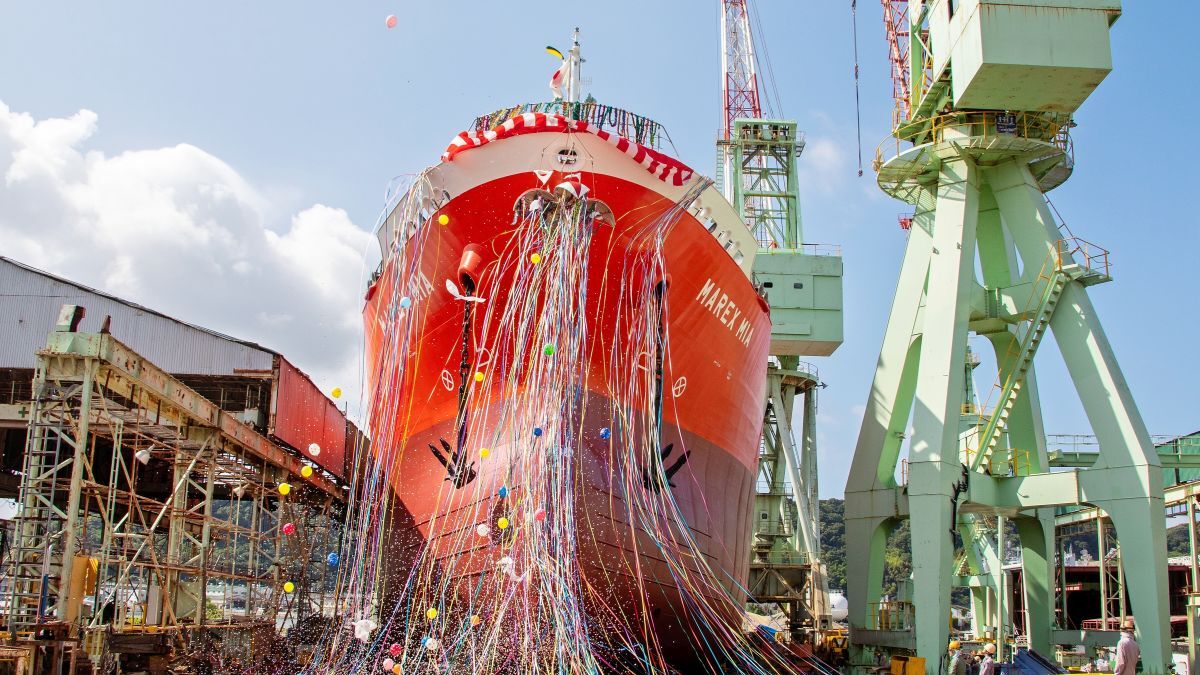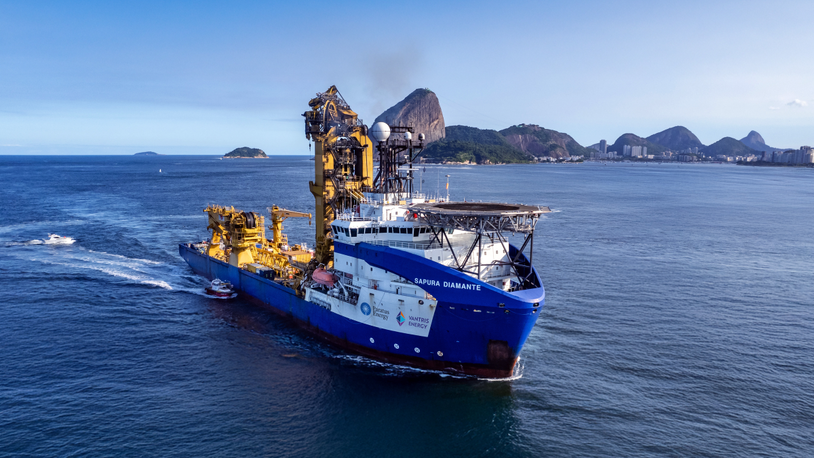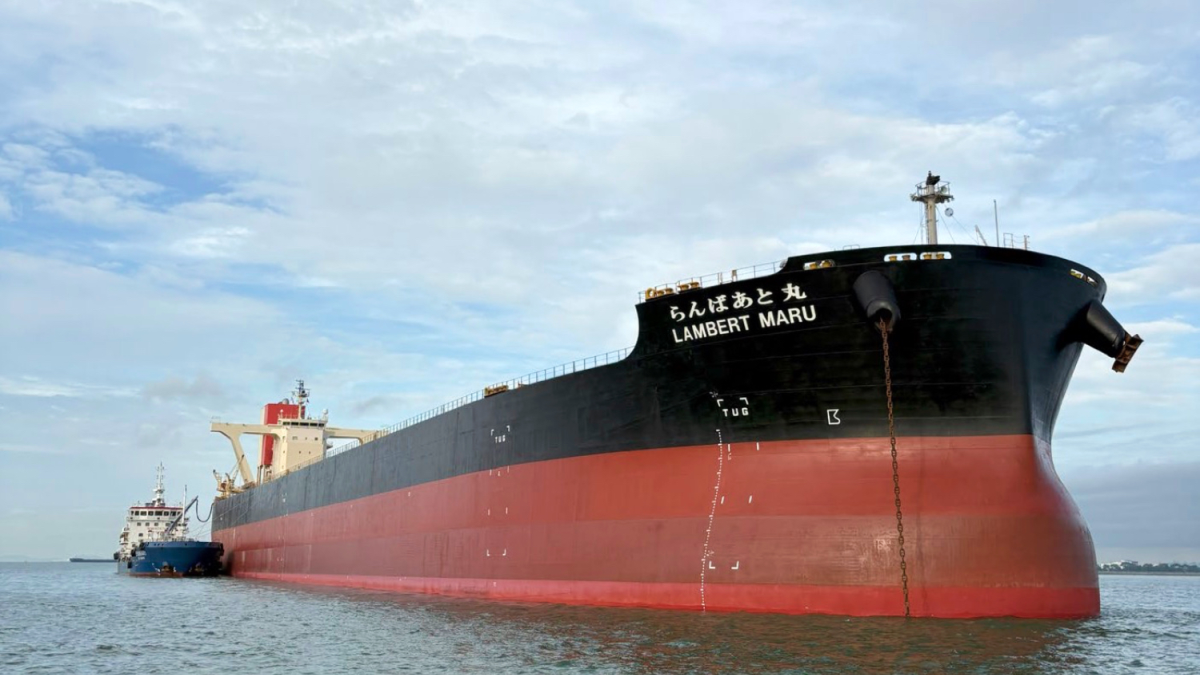Business Sectors
Contents
Azimuth thrusters push deeper into mainstream propulsion
Offshore vessel, ferry and tanker operators are specifying fully-rotatable thruster systems for higher propulsive efficiency, manoeuvrability and redundancy
Growing references and sound service experience are reported by Rolls-Royce for its Ulstein Aquamaster Azipull, a mechanical azimuth thruster equipped with a pulling propeller which may be either CP or fixed pitch. The design opened the door to thrusters in higher speed applications, up to around 25 knots.
Mechanical elements are enclosed in a hydrodynamically-optimised leg with a wide chord to provide rudder effect and improve course stability. The streamlined leg incorporates a skeg extending below the gear housing, both leg and skeg recovering swirl energy from the slipstream of the pulling propeller. Overall propulsive efficiency is thus increased because the otherwise wasted energy is converted to a forward force on the thruster leg.
Water flow to a pulling propeller is only determined by the hull, and it is possible to secure a more homogeneous inflow to the propeller with this type of thruster, says Rolls-Royce. A more uniform inflow is decisive for reducing unsteady cavitation and thereby curbing propeller-induced noise and vibration and lowering oscillations in shaft torque.
Housed within the hull are the upper gear housing, steering gear and ancillaries, these elements adopted from the standard Ulstein Aquamaster azimuth thruster range to maximise commonality of spares and minimise technical risk. The lower bevel gear and pitch-setting mechanism is based on group experience in designing and manufacturing earlier generations of thruster.
Summarising the main characteristics of the Azipull thruster, Rolls-Royce cites:
• low drag, high efficiency
• high hydrodynamic and total efficiency
• low noise and vibration levels
• course stability
• continuous service speed of 24 knots while maintaining good manoeuvrability
• mechanical or electric drives by diesel engine or gas turbine
• CP or fixed pitch propellers.
Successful service experience is reported for Azipulls powering Fjellstrand’s prototype FerryCat double-ended ferry Stavanger on the Stavanger-Tau route in Norway. With seating capacity for 252 passengers and a vehicle deck accommodating 120 cars, the aluminium-hulled vessel typically makes 15 round trips a day.
A speed of 22 knots (around twice that of traditional ferries on the same route) is maintained by the four 1,340kW Azipull AZP085 thrusters, each direct-coupled to its associated diesel engine. The thrusters are mounted at each corner of the symmetrical catamaran hull, providing good manoeuvrability. Ease of control is facilitated by linkage to the new Poscon joystick system. In the event of thruster damage or engine failure, the FerryCat can proceed at 18 knots on three units with a reserve of propulsion redundancy.
Two similar FerryCats are in service with a Turkish operator, the four Azipulls per shipset each having a rating of 1,500kW.
Trials of the first offshore service vessel to be equipped with Azipulls in a retrofit project demonstrated the benefits over the replaced standard azimuth thrusters and showed valuable qualities in a 15-knot application. The twin propulsors of Bourbon Tampen (ex-Havila Tampen) yielded a power reduction of 900kW in achieving the original maximum speed of 15.1 knots (alternatively, an extra 0.6 knots was available at the original power rating).
A power reduction of around 15 per cent was calculated after allowing for propeller fouling on the former thrusters, with a substantial decrease in fuel consumption reported in daily service.
Vibration was also considerably reduced. Another anticipated result was improved course stability from the much increased rudder area provided by the Azipull legs, with smaller steering angles needed to maintain heading.
A number of other offshore service vessels have since been fitted with Azipulls at the newbuilding stage, and others are on order.
Interest from the mainstream cargo shipping sector has attracted a number of orders for Azipulls to serve small tankers requiring particularly good manoeuvring characteristics for intensive multi-port itineraries.
Commissioned by the Norwegian owner Bergen Tankers from the RMK Marine yard in Turkey for delivery later this year, a 4,200 dwt product carrier designed by Rolls-Royce group member NVC-Design is specified with twin Azipulls served by independent propulsion lines. Each AZP85 thruster with CP propeller will be driven by an associated engine developing 1,400kW at 900 rpm, which also drives a 1,000kW shaft alternator.
A good course-keeping ability was sought in developing the hull form. In the past, says Rolls-Royce, hulls with length-to-beam ratios desirable for low first-cost and high earning capacity tended to have poor course stability when propelled by azimuth thrusters. The large steering corrections required resulted in higher fuel consumption.
Azipulls are said to help in this respect as their hydrodynamically-optimised underwater element provides a substantial rudder area. A programme of computational design and model testing was nevertheless undertaken by NVC-Design to secure a tanker with course stability well in excess of the IMO zig-zag test requirements. The propulsors are positioned below the headboxes, allowing the aft end of the hull to be optimised for minimal resistance and a more simplified construction.
The same NVC-Design concept covers a range of product tankers for coastal and deepsea trading with capacities from 3,000 dwt to 20,000 dwt, the upper limit depending on the required speed and ice class. Among the advantages claimed for the design is a higher cargo capacity (5-7 per cent more) compared with a conventional single-screw tanker, since the thrusters allow the engineroom bulkhead to be moved further aft. This is said to compensate for the slightly increased construction cost of the twin-Azipull solution, cutting the payback time for the extra investment.
Due for delivery in 2006/2007 are four Azipull-propelled oil products/chemical tankers ordered by Brostrom Tankers of Sweden from China’s Jinling Shipyard. The 14,500 dwt design seeks maximum safety with minimal environmental impact in mainly North European shortsea trading. Each of the twin Azipull thruster shipsets will be driven by an MAN B&W 7L27/38 medium speed engine developing 2,380kW for a service speed of around 13 knots.
An unusual installation (in terms of ship type and size) for standard Ulstein Aquamaster azimuth thrusters will enter service with four 15,000 dwt ice class 1A products/chemical tankers booked from Cicek Shipyard in Turkey for the domestic H I Kaptanoglu group’s KS Tankers. The first of the series, Puli, was launched in December, the largest such tanker yet built in the country.
Each of the twin CP thrusters is direct-coupled to an 8-cylinder Bergen B32:40 engine developing 3,600kW at 720 rpm, the outfit intended to yield a fully laden service speed of 15 knots at 85 per cent maximum continuous rating.
“It is unusual that the customer has chosen azimuth thruster propulsion for this type of vessel, “ notes Rolls-Royce sales manager for the sector, Borge Nogva. “ The reason is to improve manoeuvrability and reduce the need for tug assistance in confined waterways and harbours. Another advantage is that the propulsion system, with independent twin thrusters, provides full redundancy and emergency propulsion as well.”
Record sales in newbuilding and service sectors were reported in 2004 by German thruster and pod specialist Schottel, with exports accounting for around 80 per cent. Propulsion systems for tugs, offshore supply vessels and tankers, research ships, ferries and military vessels again made a major contribution but the propulsion and manoeuvring requirements of megayachts represent an increasing source of business.
This year will see the number of tugs worldwide benefiting from Schottel propulsion and manoeuvring systems comfortably exceed 600. Power ratings and bollard pulls have risen significantly since the first vessel equipped with the company’s Rudderpropellers entered Hamburg harbour service in 1967.
Orders booked in 2004 called for twin Rudderpropeller sets for around 75 tugs, the units ranging in power from 500kW to 3,850kW with fixed or CP propellers.
Propulsion systems for some 15 offshore industry vessels were also commissioned. Notable among these are two SRP 3030 CP Rudderpropellers (2,970kW at 750 rpm apiece) for a 49.5m-long offshore support tug design newly developed in Canada by naval architects Robert Allan Ltd. Commissioned by US-based Seabulk Offshore from Labroy Shipbuilding & Engineering in Singapore, the tug will also be fitted with a 450kW Schottel type STT 330 LK CP transverse thruster.
A bollard pull of 124 tonnes is anticipated from two 54m rescue/salvage tugs building at Astilleros Armon Vigo for the Spanish coastguard service. Each will feature a pair of SRP 3040 CP Rudderpropellers, with ratings of 3,840kW at 600 rpm, and a 400kW STT 330 LK CP transverse thruster.
Sustained success is reported for the high efficiency Schottel Twin Propeller (STP) variant of the Rudderpropeller, with propulsion references ranging from European river cruise ships to offshore tonnage in arduous service. Thrust is generated by two propellers rotating in the same direction on a single shaft, a concept adapted for the Siemens-Schottel Propulsor (SSP) pod drive with ratings up to 20MW.
SSPs are reportedly proving reliable in TT-Line Baltic ropax ferries, heavy lift transport vessels operated by COSCO and chemical tankers deployed by Donsotank Reederi of Sweden, the latter having since specified an SSP for a fourth tanker newbuilding.
Seagoing debuts have also been logged for a smaller pod drive, the Schottel Electric Propulsor (SEP), which is available in power ratings up to around 5,000kW.
Twin SEP 2 units (1,850kW apiece) are now providing main propulsion for the multi-purpose vessel Arkona, built for the German Water Board for spillage incident and icebreaking duties in the Baltic. Manoeuvrability is enhanced by a 1,000kW Schottel SPJ 220 Pump-Jet arranged in the bow.
Maria S Merian, a new German research vessel with ice class GL-E-4 notation, also features two SEP 2 units for main propulsion (but with maximum ratings of 2,100kW) and a 2,200kW SPJ 320 Pump-Jet. More powerful SEPs (5,500kW each) will be paired to propel the Royal Netherlands Navy’s landing ship dock (LPD-2) Johan de Witt.
Schottel’s portfolio now includes the Schottel Combi Drive (SCD), a hybrid of the mechanical Rudderpropeller and the electric pod. In contrast to pod drives, with the motor inside the underwater housing, the SCD’s motor is integrated vertically into the support tube of a Rudderpropeller. Neither an above-water gearbox nor a cardan shaft is required, making the system very compact and easy to install, says Schottel.
Based on the company’s SRP 1515, 2020 and 3030-type Rudderpropellers, the electro-mechanical SCD covers a power input range from 1,900kW to 3,800kW with propeller diameters from 2,500mm to 3,500mm. Azimuthing steering can be effected by hydraulic or electric motors and units are offered in both push propeller with nozzle and twin-propeller versions.
An expanded product range has increased the importance of Schottel’s plant in Wismar, north Germany, in supporting the main Spay/Rhine facility. Propulsion systems with power ratings of well over 2,000kW per unit are now built there, along with both mechanical and electric pod drives.
Continuing demand for its Z-Drive rudder propellers is reported by Veth Motoren, the Dutch specialist recently extending its reference list with two VZ-1250-CR type units for the large Rotterdam-based bunkering tanker Jade. Each has a rating of 1,250kW at 1,800 rpm and contra-rotating propellers with diameters of 1,640mm and 1,500mm.
Veth Motoren also supplied a Veth-Jet bow thruster and a Veth-Compact-Jet (also used as a bow thruster), each rated for 404kW at 1,800 rpm, to secure a high degree of manoeuvrability in conjunction with the Z-Drives.
The contra-rotating propeller version of the Z-Drive offers advantages over the single-propeller unit in terms of higher efficiency, quieter operation and smaller diameters for more compact installations. The first propeller imparts extra thrust to the second propeller, which in turn causes the water flow to straighten. These factors combine to improve overall propulsive performance by up to 15 per cent, Veth claims.
Input power is divided between both propellers, each blade thus subjected to lower loads. It is also possible to increase the power input to the unit using smaller propeller diameters than would be required with an equivalently rated single-propeller thrusters. The optimum rotational speed is also much lower. Together with the higher number of blades in the system, this contributes to a lower noise level.
A multi-plate clutch built into the Veth-Z-Drive contributes to a short overall length, its robustness allowing the frequent gear changing associated with ferries. Noise is minimised by incorporating helical gear wheels with low resistance, and installations can be flexibly mounted to prevent direct contact with
the hull.
A new version, the VZ-160-CR, has been purpose-developed for luxury yachts and small passenger vessels, the contra-rotating design featuring twin propellers with diameters of 600mm and 550mm and having a maximum input power of 160kW. The specification addresses the demand of the targeted sectors for very quiet operation. MP
Related to this Story
Events
LNG Shipping & Terminals Conference 2025
Vessel Optimisation Webinar Week
Marine Coatings Webinar Week
© 2024 Riviera Maritime Media Ltd.













